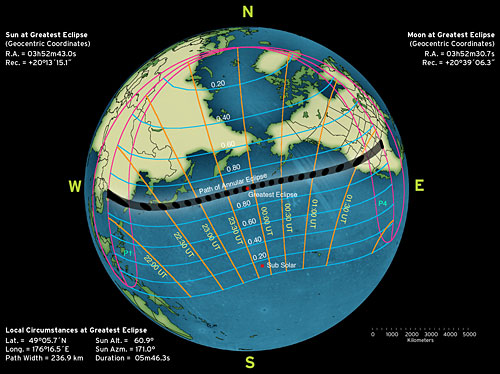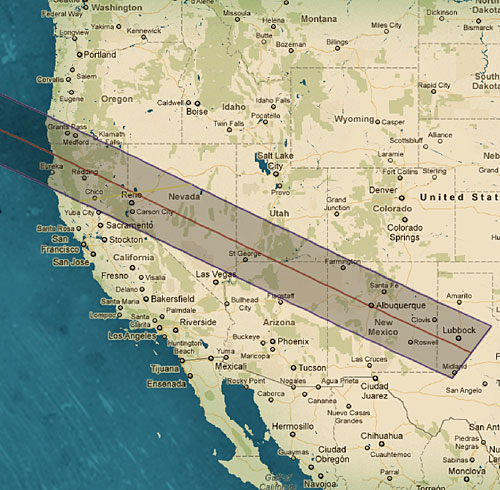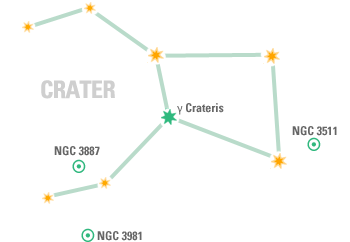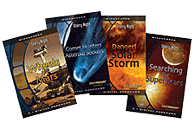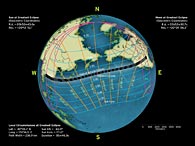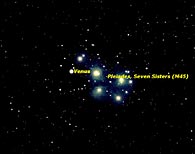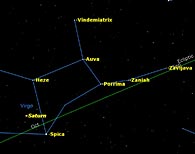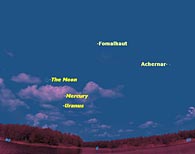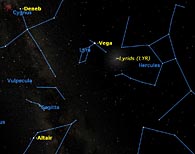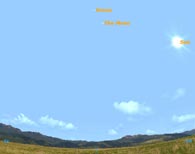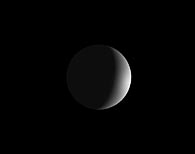 |
||||||||||||||||||||||||||||||||||||||||||||||||||||||||||||||||||||||||||||||||||||||||||||||||||||||||||||||
For education orders please call 1-877-290-8256. Welcome again to our monthly newsletter with features on exciting celestial and earth science events, product reviews, tips & tricks, and a monthly sky calendar. We hope you enjoy it!
Astronomy Day is usually held on a spring Saturday close to a first quarter Moon. Astronomy Day is very late this year, occurring on the last Saturday of April. This has the disadvantage that it doesn't get completely dark until quite late, after 10PM Daylight Time. However the presence of the Moon and three bright planets in the early evening sky gives us plenty to show the public while waiting for the sky to get completely dark. As usual on Astronomy Day, the Moon will be well placed. Its phase will be a waxing crescent, a day before First Quarter. This places the terminator well for observation. In particular, the Apollo 11 landing site in the Mare Tranquillitatis will be well placed under the rising Sun. I find it useful to have a fairly small telescope at low power on the Moon to show the whole picture, and a second larger telescope with a high magnification focused on a particular area, such as the Apollo landing site. It always helps to have some facts and figures available as talking points, such as the names and sizes of prominent craters like Theophilus and Posidonius. The latter is one of my favorite craters because of its complex floor. It has several small craters and an interesting pattern of rilles, shallow grooves where apparently lava tubes have collapsed.
Venus will be high in the western sky, and just two days short of its greatest brilliancy on April 30. Mention to your viewers that it's about equal to Earth in size, but its climate represents the greenhouse effect gone wild, with surface temperatures of 860° Fahrenheit (460° Celsius). Although beautiful to the naked eye, Venus is always a disappointment in a telescope, a blank white crescent. It will be worth mentioning the upcoming transit of Venus on June 5 (June 6 in the eastern hemisphere). The second planet on view is Mars. By late April it will have shrunk to 10 arc seconds in diameter. This will make it hard to see much detail, except in large high quality telescopes. An orange filter often enhances the contrast of the polar cap and dark markings, as well as giving Mars the color people expect.
Saturn never fails to please. Don't be afraid to bump up the magnification. Saturn can tolerate at least 200x in all but the smallest telescopes. Be sure to point out Titan, Saturn's largest moon. If the telescope is 6" (150mm) aperture or larger, you should be able to see two or three more moons; use Starry Night to identify them ahead of time. Double stars are always crowd pleasers. Three of my favorite doubles at this time of year are Castor in Gemini, Algieba in Leo, and Izar in Boötes. I'm always a bit reluctant to recommend deep sky objects for public observing nights. While these may be exciting for experienced astronomers, they usually fail to impress non-astronomers. Star clusters are probable the most impressive, and the Beehive in Cancer is one of the finest. M3 in Canes Venatici is one of the finest globular clusters in the sky. A telescope 6" (150mm) or larger in aperture will resolve it into stars at 100x. Galaxies are often major disappointments for the public unless you are at a dark location and have a large scope at your disposal. My favorites are Messier 81 and Messier 82 in Ursa Major. They are both bright, and their shapes make an interesting contrast. Other bright galaxies are the Leo Triplet (M65, M66, and NGC) and the Sombrero (M104). M95, also in Leo, might be worth a look if the recent supernova is still visible. Again, I recommend having a few "fun facts" on hand for the objects you are showing. Starry Night can provide you with plenty of these if you use the Show Info command. Have a great Astronomy Day! Clear skies! Geoff Gaherty
On April 1 of this year, Venus has just passed its greatest angular separation from the Sun as shown by the graphic at left. The curved line represents Venus' orbit.
A small telescope will suffice to show the half illuminated disk of Venus although the surface features shown by the image below are hidden by a brilliant white atmosphere. On April 1 the relative positions of the Sun, Venus and Earth as seen from above the Sun's north pole are shown in the graphic at left. Please note that the images of Earth, Venus and Sun are not to scale.
As Venus moves along its orbit, it decreases its angular distance from the Sun (see graphic below left) and gets closer to Earth. These two factors combine to decrease the sunlit portion as seen from Earth making Venus appear more crescent shaped. As well, the actual size of the disk increases. The graphic below on the right shows the size of Venus at the end of the month.
The crescent size continues to increase and the disk illumination decrease as Venus moves towards inferior conjunction with the Sun. By June 1 barely 1% of the disk is illuminated and it has now reached a size of 57 arc seconds. At conjunction on June 5/6, disk illumination is 0% and Venus has reached its "New Moon" phase. This year, rather than passing above or below the Sun, Venus transits the Sun's disk.
This rare event (the next one occurs in 2117) is partially visible from eastern North America near sunset on June 5. After inferior conjunction, Venus again goes through the crescent phase towards 50% illumination in mid-August. But this time it is the opposite side that is illuminated. Growing fatter and smaller Venus eventually reaches the "Full" phase at superior conjunction next year. You can follow the entire cycle of Venus' phases using any version of Starry Night. You can also use Starry Night to check on the position of Venus during the month to help you plan your observations. When using any optical aid to observe Venus, always be aware of the Sun's position. Sunlight passing through unfiltered telescopes or binoculars can cause severe eye damage. Novice observers should wait until after the Sun has set before using their telescopes. Further Study Do other planets show crescent phases? Answer to Last Month's Question As the latitude of the observer increases, the maximum altitude of the Sun decreases. Herb Koller
In any one year we’d be thrilled with one major celestial event, but this year observers in the northern hemisphere, in addition to viewing a Venus transit, will also have the opportunity to view an annular solar eclipse on May 20, 2012. To celebrate these two rare events, Starry Night has published a comprehensive observing guide to the 2012 Venus Transit and Annular Solar Eclipse. It will be available on the iBookstore in about a week when you search for "2012 Venus Transit". Location and Times Like most solar eclipses, this eclipse will be best observed from a narrow band across the Earth’s surface where the shadow of the Moon sweeps across. This path begins at dawn in southern China. It then crosses the Pacific Ocean, passing south of Alaska, and makes landfall near the California-Oregon border. It ends near Lubbock, Texas, at sunset. Partial phases of this eclipse will be visible over most of western North America. The eclipse will appear at different times at different locations. The table below shows the predicted times for the events given in local times for selected locations in North America. In many locations, the Sun and Moon set before the eclipse is over. The best views will be from places on the central line of the eclipse, such as Albuquerque, Eureka, Lubbock, and Reno. At these locations the Moon will be entirely within the Sun’s disk. Eclipse Times for Major Cities
Path of the Annular Solar Eclipse of May 20, 2012
The global path of the May 20, 2012 annular eclipse. Greatest eclipse is defined as the instant when the axis of the Moon's shadow cone passes closest to Earth's center. P1 (partial eclipse begins) and P4 (partial eclipse ends) are regions contacted by the penumbra shadow where a partial eclipse will be visible. Eclipse predictions by Fred Espenak, NASA's GSFC.
The track of the antumbra, called the path of annularity, over the continental U.S. If you are within this path, you will see an eclipse where a ring or annulus of bright sunlight surrounds the Moon. The northern and southern path limits are blue and the central line is red. Eclipse predictions by Fred Espenak, NASA's GSFC.
May 20, 2012 Annular Solar Eclipse Pedro Braganca
Crater is a dim constellation that glides across the southern horizon at this time of year. It lies to the west of Corvus, above Hydra, and below the boundary between Virgo and Leo. Three faint galaxies are worth bagging and comparing...
Lastly, γ Crateris is a pretty 4th magnitude fixed binary star that should be fairly easy to "split" in your telescope. Sean O'Dwyer
|
APR 2012
|
|||||||||||||||||||||||||||||||||||||||||||||||||||||||||||||||||||||||||||||||||||||||||||||||||||||||||||||

|
||||||||||||||||||||||||||||||||||||||||||||||||||||||||||||||||||||||||||||||||||||||||||||||||||||||||||||||
|
||||||||||||||||||||||||||||||||||||||||||||||||||||||||||||||||||||||||||||||||||||||||||||||||||||||||||||||

 EDUCATION ORDERS 1-877-290-8256
EDUCATION ORDERS 1-877-290-8256

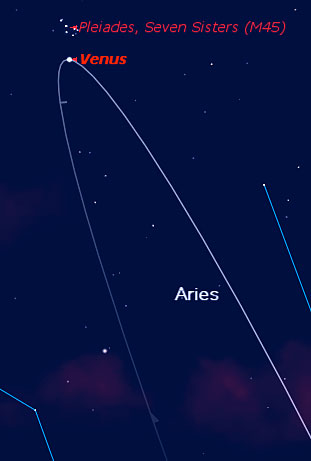 When Galileo turned his telescope towards the heavens over 400 years ago, he discovered that the planet Venus exhibited phases that mimicked those of the Moon. In particular, he observed the disk half illuminated which negated the Ptolemaic vision of the solar system.
When Galileo turned his telescope towards the heavens over 400 years ago, he discovered that the planet Venus exhibited phases that mimicked those of the Moon. In particular, he observed the disk half illuminated which negated the Ptolemaic vision of the solar system.
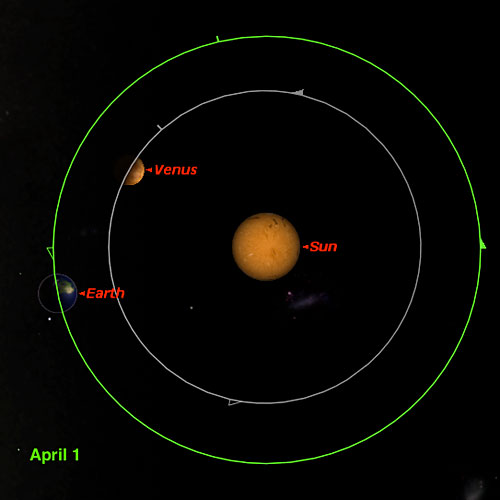
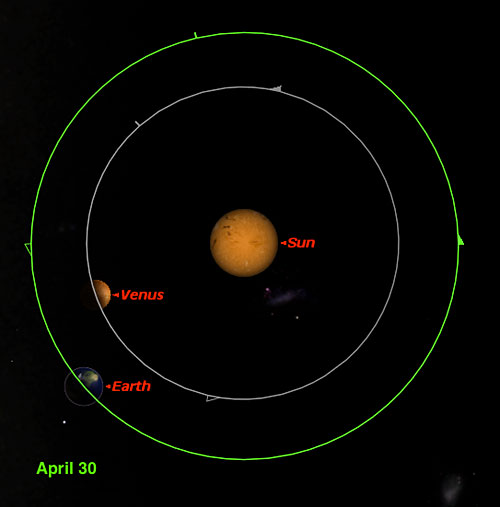
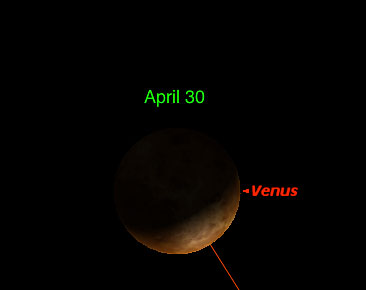 On April 30 Venus' disk is 27% illuminated. Seen from Earth, its angular size is 37 arc seconds. Compare this with 48% illumination and a size of 25 arc seconds on April 1.
On April 30 Venus' disk is 27% illuminated. Seen from Earth, its angular size is 37 arc seconds. Compare this with 48% illumination and a size of 25 arc seconds on April 1.

